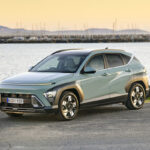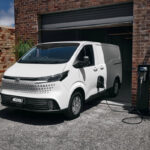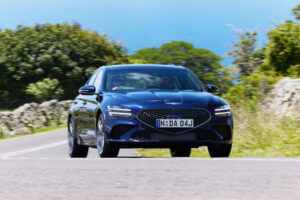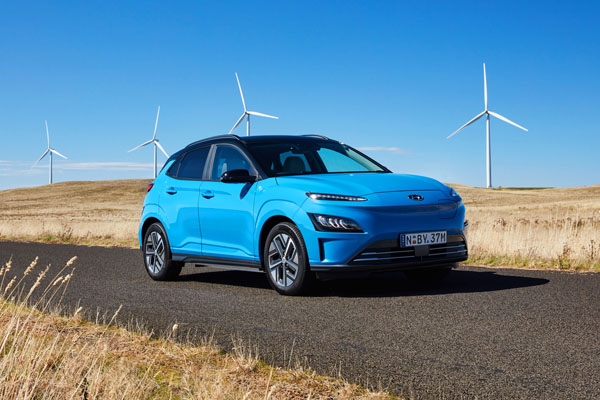
Hyundai Kona Electric is a fully electric vehicle from the Korean company that’s very serious about making the world a better place. It has received a facelifted exterior and specification upgrades. Most importantly it now has a WLTP measured driving range of 484 kilometres, it was previously 449 km.
STYLING
The Kona’s front is neatly shaped as part of its aerodynamics, there’s a small hatch in its left side which opens to accept the charging cable. The lower section of the front has what looks like a radiator grille, but it’s an inlet for cool air to keep the battery at its correct temperature.
The headlights stretch part way around the side of the car to increase its apparent width. Vertical air inlets in front of the wheelarch claddings enhance its aerodynamics by keeping the air away from disturbance created by the wheels and sending it cleanly along the side of the body.
There’s a new design of LED Daytime Running Lights at the front.
The rear has a new bumper design and horizontally-stretched rear lamps. There are machined face 17-inch alloy wheels.
INTERIOR
Now standard across the Kona Electric range is a wireless charging pad which allows compatible Qi-standard devices to be charged in a recess in the front-centre console.
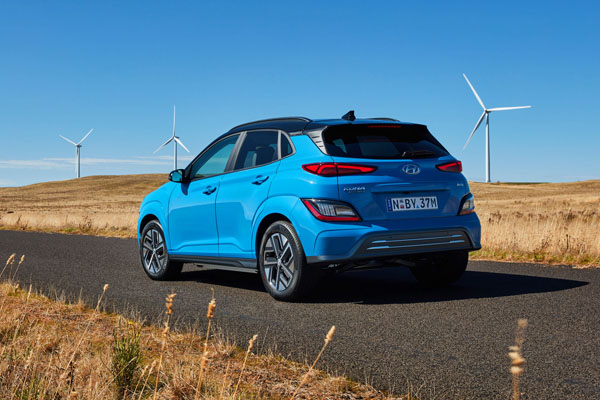
INFOTAINMENT
A large 10.5-inch horizontally mounted screen is simple to use and not only gives access to entertainment, but also detailed information on the state of charge in the battery
The Harman Kardon premium audio system has eight speakers (including a front centre speaker and a woofer) and an external amplifier. It gives excellent sound quality through optimised system tuning.
POWERTRAIN
Kona EV has a Lithium-ion Polymer 356-volt battery with 64 kWh. The electric motor is under the front bonnet and drives the front wheels through a 7.89 reduction gear.
Peak power is 150 kW while torque is a hefty 395 Nm from one rpm.
Charging time using an onboard DC 100 kW charger 10 to 80 per cent is about 47 minutes and about 64 minutes with a 55 kW charger.
A home charging station using onboard AC 7.2 kW charger to get from 10 per cent to 100 per cent in about nine and a half hours.
If you really get stuck and have to charge it from a regular 240 volt three-point electric plug. It will take about 28 hours for a full charge. Slow, but better than being stranded without power.
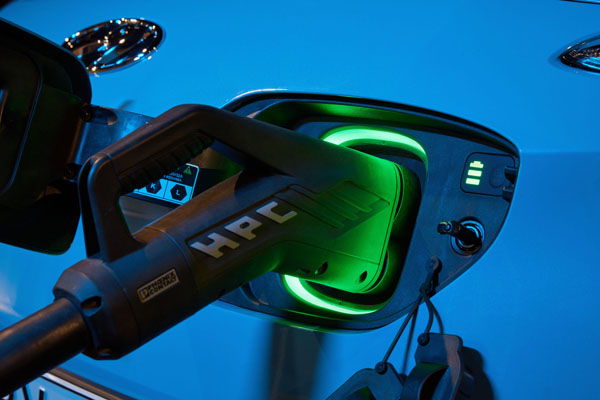
SAFETY
There’s a very strong emphasis on primary and secondary safety in the 2021 Hyundai Kona Electric.
It incorporates upgrades to the standard SmartSense safety suite. Supplementing the Lane Keeping Assist system, Lane Following Assist cameras detects lane markers and the vehicle in front of you. It provides steering assistance to ensure the vehicle stays in the centre of the lane.
At speeds of 20 km/h or above, Blind-Spot Collision-Avoidance Assist detects vehicles next to yours and diagonally behind. If a vehicle is present in the blind spot, a visual alert is displayed in the exterior mirrors. If the driver activates an indicator, a flashing visual warning is provided and an audible alert is sounded. Given that most drivers turn the steering wheel before they start to indicate this BCA could be a crash saver.
At speeds of 60km/h or above, if the driver proceeds to carry-out a lane change after the audible alert is sounded, BCA will apply partial braking to the wheels on the opposing side of the potential collision point. This hopefully brings the vehicle away from danger.
BCA can also help prevent collisions when exiting a parallel parking spot at 3km/h or lower. If a potential collision with an approaching vehicle is detected, the system will apply braking force to help avoid a collision.
Rear Cross-Traffic Collision-Avoidance Assist monitors for traffic approaching on either side of the Kona when reversing out of perpendicular parking spaces at speeds of up to 8km/h. Should RCCA detect a vehicle approaching, an audible warning will sound, with a visual warning displayed on the dash cluster. If the driver does not adhere to the warning, RCCA will apply a braking force and help avoid a collision.
The Safe Exit Warning helps occupants utilises the radar sensors on either side of the rear bumper to detect vehicles approaching from the rear. If a vehicle is detected and a door is opened, the system will sound an audible alert and display a visual warning in the instrument cluster.
Rear Occupant Alert detects the entry of occupants via the rear doors opening and closing. Upon parking and opening the driver’s door, the system gives an audible chime and gives a visual warning message to “check rear seats”, to ensure that rear occupants are not accidentally left behind.
DRIVING
As always, the first thing we enjoy about any electric vehicle is the instant response the moment we move the accelerator. There’s peak torque on hand from just one rpm and the 395 Nm of grunt is there virtually all the time.
You can adjust the amount of battery regeneration using paddles behind the steering wheel. We chose maximum regeneration but initially found ourselves slowing too much or too little as we juggled the accelerator.
After a few days driving we had pretty well perfected this and were pleased that we were not only saving electricity and increasing the driving range, but also minimising brake pad wear.
First time owners may choose to start on less regeneration then gradually work up to their chosen level. We know that those going electric are conscious of helping to minimise climate change so are very likely to choose maximum regeneration. Well done guys and gals…
There’s more road noise than we like but that’s possibly due to there being virtually no sound from the powertrain. Noise was at its loudest on concrete motorway surfaces and on some recently resurfaced coarse-chip country roads.
We were impressed by the distance to empty readings corresponding almost exactly with the distance travelled. So, there will hopefully be no occasions when you’re getting short of battery range and still have a fair way to go to the next charging station.
Handling isn’t set up for sporty driving but the Kona EV responds well to steering input and there’s only a little understeer when pushed hard at bends on our favourite road test route.
SUMMING UP
Hyundai Kona Highlander Electric is a solid move towards the time when only electric vehicles can be sold new. Okay, that’s many years away, particularly in Australia where politicians are very keen to please the oil industry moguls.
AT A GLANCE
MODEL RANGE
Kona EV Elite: $62,000
Kona EV Highlander: $66,000
Note: These prices do not include government or dealer delivery charges. Contact your local Hyundai dealer for drive-away prices.
SPECIFICATIONS (Hyundai Kona Highlander electric five-door wagon)
PERFORMANCE:
Maximum Power: 150 kW
Maximum Torque: 395 Nm
CO2 Emissions: 5 g/km
DIMENSIONS, WEIGHT AND CAPACITIES:
Length: 4180 mm
Wheelbase: 2600 mm
Width: 1800 mm
Height: 1555 mm
Turning Circle: 10.6 metres
Kerb Mass: 1685 kg
BRAKES:
Front: Ventilated disc
Rear: Solid disc
STANDARD WARRANTY:
Five years / 100,000 kilometres




